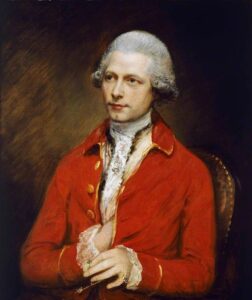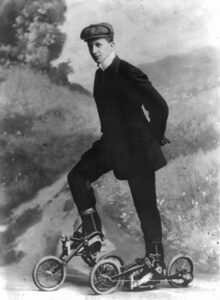
 John Joseph Merlin, who was actually born Jean-Joseph Merlin, was a Belgian clockmaker, musical-instrument maker, and inventor. Born on September 6, 1735, in Huy, a town in what was then the Prince-Bishopric of Liège and is now in Belgium, Wallonia. His parents Maximilien Joseph Merlin (a blacksmith) and his wife Marie-Anne Levasseur. Merlin’s parents had married in 1732, and Merlin was the third of six children. Sadly, his mother died when he was eight. His father remarried at least once, to Marie Therese Dechesalle in 1743, and had another child, Charles Merlin. The family moved several times. From ages 19 to 25, Merlin lived in Paris, where he was involved in the Paris Academy of Sciences.
John Joseph Merlin, who was actually born Jean-Joseph Merlin, was a Belgian clockmaker, musical-instrument maker, and inventor. Born on September 6, 1735, in Huy, a town in what was then the Prince-Bishopric of Liège and is now in Belgium, Wallonia. His parents Maximilien Joseph Merlin (a blacksmith) and his wife Marie-Anne Levasseur. Merlin’s parents had married in 1732, and Merlin was the third of six children. Sadly, his mother died when he was eight. His father remarried at least once, to Marie Therese Dechesalle in 1743, and had another child, Charles Merlin. The family moved several times. From ages 19 to 25, Merlin lived in Paris, where he was involved in the Paris Academy of Sciences.
He moved to England in 1760. He began working with a man named James Cox in 1766, creating automatons such as Cox’s timepiece and the Silver Swan. He really took to the work, and by 1773 he was designing and making innovative keyboard instruments. In 1783, Merlin decided to do something new, so he opened Merlin’s Mechanical Museum in Princes Street, Hanover Square, London, which became a meeting-place for the gentry and nobility. At this point, Merlin expanded his horizons, and in addition to his clocks, musical instruments and automata, he invented inline skates…in the 1760s.
Merlin invented inline skates, which he called skaites. Merlin’s skaiteshad two wheels in the 1760s. The skaites were mentioned by Thomas Busby’s Concert Room and Orchestra Anecdotes (1805). The mention was not would have been exactly complimentary either, because it mentions an accident Merlin had while demonstrating his skaites.
“One of his ingenious novelties was a pair of skaites contrived to run on wheels. Supplied with these and a violin, he mixed in the motley group of one of Mrs Cowleys’ masquerades at Carlisle House; when not having provided the means of retarding his velocity, or commanding its direction, he impelled himself against a mirror of more than five hundred pounds value, dashed it to atoms, broke his instrument to pieces and wounded himself most severely.”
In case that all sounded a little confusing, let me simplify. Basically, Merlin didn’t practice using…or rather stopping, his skaites before he demonstrated them. His “stumbling” start aside, Merlin went on to invention other things, including a self-propelled wheelchair, a prosthetic device for “a person born with stumps only,” whist cards for the blind, a pump for expelling “foul air,” a communication system for summoning servants, a 
 pedal-operated revolving tea table, and a mechanical chariot with an early form of odometer. Merlin died in Paddington, London on 8 May 1803. His collection was sold to Thomas Weeks of Great Windmill Street. Weeks died in 1834, at which time Merlin’s creations were auctioned off with Weeks’ other possessions. One of Merlin’s automatons, a dancer with an automated bird, was bought at the auction by Charles Babbage for 35 pounds. He had seen it as a child at Merlin’s Mechanical Museum.
pedal-operated revolving tea table, and a mechanical chariot with an early form of odometer. Merlin died in Paddington, London on 8 May 1803. His collection was sold to Thomas Weeks of Great Windmill Street. Weeks died in 1834, at which time Merlin’s creations were auctioned off with Weeks’ other possessions. One of Merlin’s automatons, a dancer with an automated bird, was bought at the auction by Charles Babbage for 35 pounds. He had seen it as a child at Merlin’s Mechanical Museum.


Leave a Reply